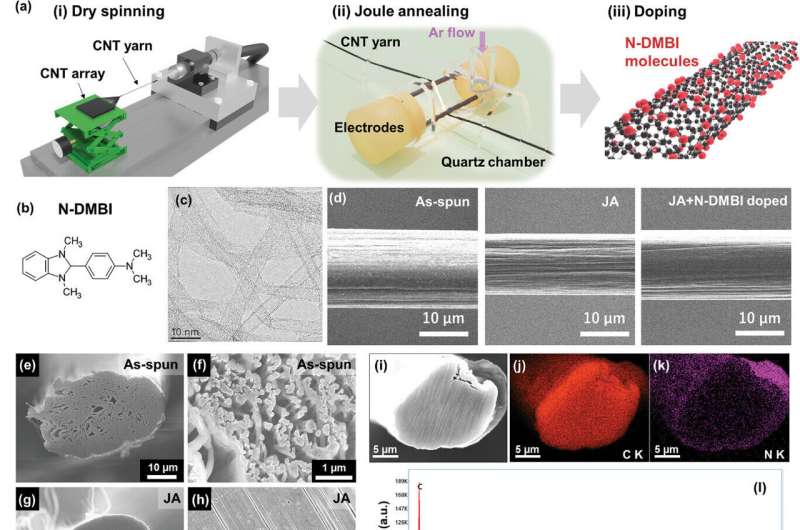This article has been reviewed according to Science X's editorial process and policies. Editors have highlighted the following attributes while ensuring the content's credibility:
fact-checked
peer-reviewed publication
trusted source
proofread
Novel carbon nanotube yarns can generate electricity from waste heat

In line with global efforts towards sustainability, the development of energy harvesting technologies has become a top research priority. Although renewable energy sources like wind and solar power have recently taken the spotlight, waste heat also stands as a largely untapped source of energy. Using thermoelectric materials, industrial waste heat can be harvested and converted into electrical energy, which can help increase the efficiency of industrial processes.
Unfortunately, this approach is less straightforward for "low-grade" waste heat (waste heat reaching temperatures below 200°C). The main problem is that the thermoelectric materials available at this temperature range are quite limited. Most thermoelectric inorganic materials are either toxic, prohibitively expensive to produce, or too rigid for applications that call for flexibility (such as wearable electronics).
Against this backdrop, a research team including Research Associate Professor Hiroo Suzuki from Okayama University, Japan, have been studying the application of carbon nanotube (CNT) yarns in thermoelectric conversion.
In a study, whose findings were published on March 12, 2024, in Small Methods, they addressed a major roadblock in this particular area: the lack of high-performance n-type CNT yarns (CNT yarns with an excess of electrons) for low-grade waste heat, as opposed to p-type CNT yarns (yarns with excess of positive charge carriers). This paper was co-authored by Jun Kametaka, Takeshi Nishikawa, and Yasuhiko Hayashi, all from Okayama University.
"Constructed from CNTs, CNT yarns are well-suited for practical applications as the yarn-like structure allows for the fabrication of flexible thermoelectric devices such as fabric-based modules," explains Dr. Suzuki.
"Although recent reports have showcased p-type CNT yarns with a remarkable thermoelectric power factor, the absence of similar n-type CNT yarns imposes limitations for device configurations involving π-type modules, which require both p- and n-type CNTs to achieve high efficiency."
To tackle the problem, the research team sought to establish a novel doping (impurity addition) method to efficiently produce n-type CNT yarns. They selected 4-(1, 3-dimethyl-2, 3-dihydro-1H-benzimidazole-2-yl) phenyl) dimethylamine (N-DMBI) as a promising dopant owing to its high stability in air, which is essential in most practical applications.
First, the researchers spun CNT yarns using a dry spinning technique. These yarns then underwent a "Joule annealing process," which subjects the material to an electric current until it reaches a precisely controlled high temperature.
The logic underlying this processing step is that the transient heat increases the crystallinity of the CNTs, thus reducing their thermal conductivity. In turn, this improves their thermoelectric performance. Moreover, Joule annealing greatly enhances the mechanical properties of the yarn.
Next, the team sought to establish an optimal N-DMBI doping protocol for the CNT yarns. "The optimization of the doping process involved rigorous selection of a suitable solvent. We evaluated ten different options, including nonpolar solvents, polar aprotic solvents, and polar protic solvents," comments Dr. Suzuki. "We ultimately identified o-dichlorobenzene as the most suitable solvent for N-DMBI doping at low temperatures, based on an analysis of the resulting Seebeck coefficient of the CNT yarns."
After extensive experimentation, the team reported that the annealed, n-doped CNT yarns achieved a remarkably high thermoelectric power factors within temperatures ranging from 30 to 200°C, along with a high figure of merit (a numerical expression representing the performance or efficiency of a material). They further tested this n-type material in a prototype π-type thermoelectric generator, which could produce electricity even at only 55°C and a temperature difference of 20°C.
"Achieving power generation at low temperatures with small temperature differences is significant for the development of thermoelectric modules that can tap into various thermal sources, such as waste heat from industrial facilities, thermal dissipation from vehicles, and even body heat," remarks Dr. Suzuki.
"Our research can thus help address energy problems faced by society, contributing to energy saving through the efficient use of otherwise wasted energy. Furthermore, thermoelectric generators can be used as a local energy source to drive IoT devices, such as flexible health sensors."
Overall, the insights obtained through this study could lead to the development of better organic thermoelectric materials, paving the way for more efficient energy harvesting from waste heat.
More information: Hiroo Suzuki et al, N‐DMBI Doping of Carbon Nanotube Yarns for Achieving High n‐Type Thermoelectric Power Factor and Figure of Merit, Small Methods (2024). DOI: 10.1002/smtd.202301387
Journal information: Small Methods
Provided by Okayama University




















